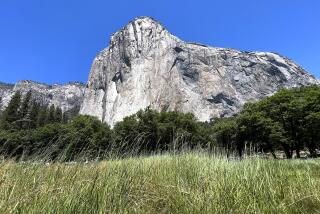Our Heritage in the Parks
- Share via
Back in the ice-age days of James G. Watt as secretary of the interior, the Reagan Administration made a big deal about spending $1 billion on the national parks. But the money, over a five-year period, actually went into roads, sewage systems and other man-made facilities for park users, not the park resources themselves. The real gauge of the state of the national park system today was the need for Donald P. Hodel, the present secretary, to assure Americans recently that no parks would have to be closed in the coming year because of budget pressures.
That presumably was meant to be a comforting statement following Park Service Director William Penn Mott’s warning last summer that Yellowstone or Yosemite might have to be shut down for a full year beginning in 1988 if the service had to swallow any further budget cuts.
The idea was absurd, of course, and Congress certainly would not have stood for it. But the episode illustrates the damage done by years of Park Service fiscal starvation. A partial solution that would impose no new drain on the Treasury is before Congress and deserves passage this year.
Sen. Dave Durenberger (R-Minn.) is sponsoring a 10-year, $500-million park restoration and improvement program that would use increased park entrance fees to restore damaged resources, protect threatened areas and improve Park Service staffing and training in natural and cultural resources management. It also would require parks to anticipate future problems through the development of management plans every five years. Durenberger is correct in saying that Americans are willing to pay a little more, up to a maximum $5 per auto visit, “if they know their money will go directly to preserving black bears, or geysers, or archeological ruins.” The new fees essentially would be at the level approved by Congress last fall for one year only.
The program is a modest one, and the fees are reasonable. Because it fits the Administration’s philosophy of users paying for federal services, the White House should have no objection. The Durenberger bill is not the long-term solution to all the problems facing the parks, but passage is essential this year to stem the erosion that has occurred through growing visitor use, Park Service understaffing and the pressures of development on park perimeters.
Congress’ next priority should be to give serious consideration to Sen. Alan Cranston’s (D-Calif.) California Desert Protection Act, first introduced last year, which would extend national park or wilderness status to 14,000 square miles of federal lands ranging from the Owens Valley south to Joshua Tree National Monument. And then it should move to implement the proposals of the President’s Commission on Americans Outdoors, including a new $1-billion fund for the purchase of additional park and recreation lands and wildlife habitat.
America’s parks encompass our natural, historic and cultural heritage--essential resources for physical, mental and spiritual rejuvenation. No nation can afford to put a “Closed” sign on that.
More to Read
Sign up for The Wild
We’ll help you find the best places to hike, bike and run, as well as the perfect silent spots for meditation and yoga.
You may occasionally receive promotional content from the Los Angeles Times.






